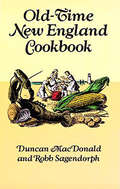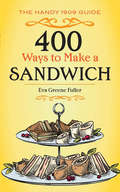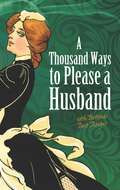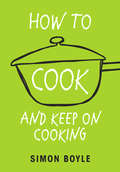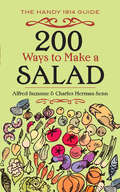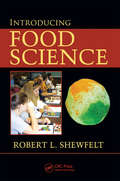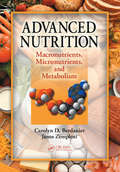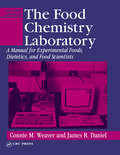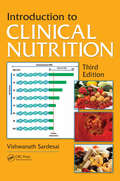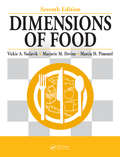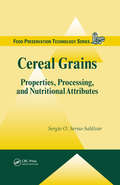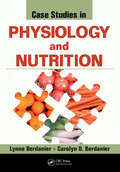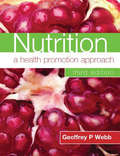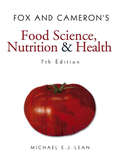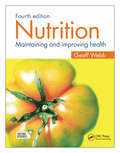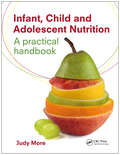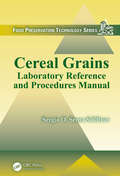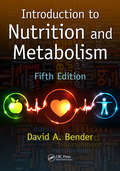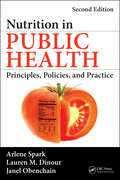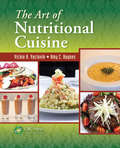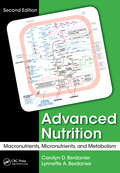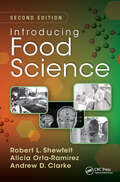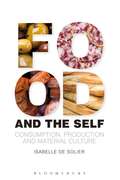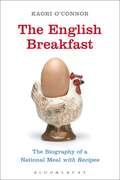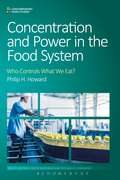- Table View
- List View
Old-Time New England Cookbook
by Robb Sagendorph Duncan MacDonaldGood old-fashioned home cooking is the keynote of this treasury of classic New England cuisine. Included are over 300 wholesome, easy-to-prepare recipes including Nantucket scallop chowder, chicken pot pie, Boston baked beans, Connecticut stuffed baked salad, apple pan dowdy, Rhode Island johnnycake, mincemeat pie, Parker House rolls, Boston cream pie, lobster five ways (boiled, baked, broiled, fried, and Newburg), Yankee pot roast, and many more.Arranged as a "seasonal cookbook," this book is designed to serve you as a sort of culinary calendar, providing useful food preparation hints and information on a day-by-day basis. The recipes call for fruits, vegetables, meat, and fish available during each season, and dishes are specially chosen to be suitable to seasonal temperatures. Moreover, the recipes are accompanied by charming observations on New England weather and the appropriateness of various foods and dishes to the time of the year.A final section contains favorite recipes from 41 famous New England inns: The Red Lion Inn, Stockbridge, Massachusetts; The Dog Team Tavern, Middlebury, Connecticut; Christmas Farm Inn, Jackson, New Hampshire; and many more. Staples of New England kitchens for generations, the dishes in this unique guide will be welcomed by anyone who delights in time-honored traditional culinary fare.
400 Ways to Make a Sandwich: The Handy 1909 Guide
by Eva Greene FullerCare for a Tutti-Frutti Sandwich? How about some Lobster Canapes? Anyone looking for new, easy ways to jazz up lunch will appreciate this eminently useful casual cookbook. Dating from the early 20th century, the vintage collection presents 400 tasty recipes based on common, easily obtained fixings. No skill is required for following the recipes, which are organized by main ingredient and offer brief, to-the-point directions. Categories include fish, egg, salad, meat, cheese, nut, sweet, miscellaneous, and canapes. A brief Foreword offers serving suggestions.
A Thousand Ways to Please a Husband: with Bettina's Best Recipes
by Louise Bennett Weaver Helen Cowles LeCronNo, you cannot live on kisses,Though the honeymoon is sweet,Harken, brides, a true word this is --Even lovers have to eat. This charming vintage cookbook, with its innocently suggestive title, reads like a novel as it follows the fictional lives of a pair of newlyweds. Join Bettina and Bob as they eat their way through their first year of marriage, from the bride's first real dinner and a Sunday evening tea to baking day, a rainy night meal, and Thanksgiving festivities. Menus for all occasions are seasoned with anecdotes about family life, friendships, household hints, and budgetary concerns. Originally published in 1917, this volume offers a delightful look at homemaking before the advent of sophisticated appliances and fast food as well as the modern reality of women's work outside the home. Unintentionally funny and historically revealing, the whimsically illustrated narrative abounds in simple and surprisingly relevant recipes.
How to Cook and Keep on Cooking
by Simon BoyleCooking the basics, with confidence! Have you always wanted to learn how to cook, but don't know where to start? Whether you're intimidated by complex recipes and glossy photographs, or you're a student moving out for the first time, this book will give you the tools you need to gain confidence in the kitchen, and experience the satisfaction of mastering a fundamental life skill. Written in a refreshingly direct and friendly style, this concise handbook covers all bases: equipment, weekly meal planners, how to follow a recipe, basic nutrition, popular cooking techniques and, of course, recipes! The recipes revolve around key ingredients - eggs, pasta, pulses, meats and stocks. With easy to follow instructions, you'll be whipping up full roast dinners, aromatic curries and deliciously sweet desserts, in no time at all. So why not take the first step? Start cooking today!
200 Ways to Make a Salad: The Handy 1914 Guide
by Alfred Suzanne Charles Herman SennThanks to an increasing interest in cultivating health-conscious habits, salads have never been more popular. This vintage recipe book from the early 20th century presents 200 fast and easy-to-follow suggestions for preparing salads and dressings that will jazz up any meal. No special culinary skills are required, and the fixings are all easily obtained from any supermarket or grocer.Organized by ingredient, the recipes include green and vegetable salads; meat, poultry, and game salads; fish salads; and fruit salads. The final two chapters provide a tasty assortment of recipes for dressings. A brief but charming Introduction offers a flavorful history of salad-making.
Introducing Food Science
by Robert L. ShewfeltAs daily consumers of foods and beverages, everyone has opinions and interests about their diet choices. However, many questions about food are often non-technical and, therefore, defy technical answers. Introducing Food Science addresses a range of food issues facing today's consumer, proceeding from a general and student-friendly discussion to an
Advanced Nutrition: Macronutrients, Micronutrients, and Metabolism
by Carolyn D. BerdanierNutrition science has evolved considerably in the past decade with new concepts and discoveries. In response, advanced nutrition courses now encompass material on macronutrients and micronutrients, subjects that have traditionally been studied separately. The brand new edition of Advanced Nutrition: Macronutrients, Micronutrients, and Metabol
The Food Chemistry Laboratory: A Manual for Experimental Foods, Dietetics, and Food Scientists, Second Edition (Contemporary Food Science Ser.)
by Connie M. Weaver James R. DanielA popular book in its first edition, The Food Chemistry Laboratory: A Manual for Experimental Foods, Dietetics, and Food Scientists, Second Edition continues to provide students with practical knowledge of the fundamentals of designing, executing, and reporting the results of a research project. Presenting experiments that can be completed, in many
Introduction to Clinical Nutrition
by Vishwanath SardesaiDietary factors have been implicated in at least four of the ten leading causes of death in the U.S. (heart disease, cancer, diabetes, and stroke). Nevertheless, physicians frequently receive inadequate training in nutrition to properly counsel their patients. Introduction to Clinical Nutrition, Third Edition discusses the physiologic and metabolic
Dimensions of Food
by Vickie A. Vaclavik Marjorie M. Devine Marcia H. PimentelMuch like its popular predecessors, the seventh edition of Dimensions of Food encourages readers to become interactive participants in understanding the physical, chemical, and functional and structural properties of food components, including the connection between conscientious food preparation and palatability and wholesome eating. With a wealth
Cereal Grains: Properties, Processing, and Nutritional Attributes (Food Preservation Technology Ser.)
by Sergio O. Serna-SaldivarWhile cereals remain the world's largest food yield - with more than 2.3 billion metric tons produced annually - consumer demands are on the rise for healthier cereal products with greater nutrition. Cereal Grains: Properties, Processing, and Nutritional Attributes provides a complete exploration of the scientific principles related to domesticatio
Case Studies in Physiology and Nutrition
by Lynne BerdanierToday's knowledge of human health demands a multidisciplinary understanding of medically related sciences, and Case Studies in the Physiology of Nutrition answers the call. Dedicated to the integration of nutrition science with physiology, this text cohesively incorporates descriptions of human problems in order to stimulate students' critical thin
Nutrition: A Health Promotion Approach
by Geoffrey P. WebbThe third edition of this highly regarded introductory textbook continues to cover all aspects of nutrition, including nutritional epidemiology, social aspects of nutrition, the science of food as a source of energy and essential nutrients, and the microbiological safety of food and food processing. Its focus is on nutrition in industrialized natio
Fox and Cameron's Food Science, Nutrition & Health
by Michael Ej LeanThe seventh edition of this classic book has been entirely revised and updated by one of the leading professors of human nutrition in the UK. Written in a clear and easy-to-read style, the book deals with a wide range of topics, from food microbiology and technology to healthy eating and clinical nutrition. It also tackles the more difficult area o
Nutrition: Maintaining and improving health, Fourth edition
by Geoff WebbThe fourth edition of Nutrition: maintaining and improving health continues to offer wide-ranging coverage of all aspects of nutrition, including: Nutritional assessmentEpidemiological and experimental methods used in nutrition researchSocial aspects of nutritionThe science of food as a source of energy and essential nutritientsVariation in nutriti
Infant, Child and Adolescent Nutrition: A Practical Handbook
by Judy MoreThis evidence-based, practical guide provides an introduction to the theory behind child nutrition with practical advice on how to put that theory into practice, including case studies, key points, and activities to help readers learn. Divided into three sections, the chapters cover prenatal nutrition and nutrition throughout childhood from preterm
Cereal Grains: Laboratory Reference and Procedures Manual (Food Preservation Technology Ser.)
by Sergio O. Serna-SaldivarEmphasizing the essential principles underlying the preparation of cereal-based products and demonstrating the roles of ingredients, Cereal Grains: Laboratory Reference and Procedures Manual is a practical laboratory manual complementing the author's text, Cereal Grains: Properties, Processing, and Nutritional Attributes. Organized so that readers
Introduction to Nutrition and Metabolism
by David A. BenderUnderstanding the way in which nutrients are metabolised, and hence the principles of biochemistry, is essential for understanding the scientific basis of what we would call a healthy diet. Extensively revised and updated to reflect current knowledge of nutritional and dietary requirements, Introduction to Nutrition and Metabolism, Fifth Edition pr
Nutrition in Public Health: Principles, Policies, and Practice, Second Edition
by Arlene Spark Lauren M. Dinour Janel ObenchainThis second edition of a bestseller, Nutrition in Public Health: Principles, Policies, and Practice focuses on the role of the federal government in determining nutrition policy and influencing practice. Beginning with an overview of public health principles, the book examines the application of nutritional policy to dietary guidance, health promot
The Art of Nutritional Cuisine
by Vickie A. VaclavikNow more than ever, culinary professionals are expected to provide cuisine that satisfies the diverse nutritional needs of a vast population of consumers. While the public has become increasingly health conscious, chefs can serve well-presented, great-tasting, and nutritious foods that at the same time support a healthy lifestyle. The Art of Nutrit
Advanced Nutrition: Macronutrients, Micronutrients, and Metabolism, Second Edition
by Carolyn D. Berdanier Lynnette A. BerdanierExpanded and updated, the new edition of Advanced Nutrition: Macronutrients, Micronutrients, and Metabolism continues in the tradition of its predecessor, serving as an essential textbook for advanced undergraduate and first-year graduate students studying human nutrition. The book incorporates fundamental concepts in nutrition science-while also a
Introducing Food Science
by Robert L. Shewfelt Andrew D. Clarke Alicia Orta-RamirezWritten as an introductory food science textbook that excites students and fosters learning, the first edition of Introducing Food Science broke new ground. With an easy-to-read format and innovative sections such as Looking Back, Remember This!, and Looking Ahead, it quickly became popular with students and professors alike. This newly r
Food and the Self: Consumption, Production and Material Culture (Materializing Culture)
by Isabelle De SolierWe often hear that selves are no longer formed through producing material things at work, but by consuming them in leisure, leading to 'meaningless' modern lives. This important book reveals the cultural shift to be more complex, demonstrating how people in postindustrial societies strive to form meaningful and moral selves through both the consumption and production of material culture in leisure. Focusing on the material culture of food, the book explores these theoretical questions through an ethnography of those individuals for whom food is central to their self: 'foodies'. It examines what foodies do, and why they do it, through an in-depth study of their lived experiences. The book uncovers how food offers a means of shaping the self not as a consumer but as an amateur who engages in both the production and consumption of material culture and adopts a professional approach which reveals the new moralities of productive leisure in self-formation. The chapters examine a variety of practices, from fine dining and shopping to cooking and blogging, and include rare data on how people use media such as cookbooks, food television, and digital food media in their everyday life.This book is ideal for students, scholars, and anyone interested in the meaning of food in modern life.
The English Breakfast: The Biography of a National Meal, with Recipes
by Kaori O'ConnorThe English breakfast is one of the best-loved national meals in the world, an edible symbol of England and Englishness. But how did breakfast attain this distinction, what can a national meal tell us about the nation that eats it, what are the links between social and culinary change, and is there more to the English breakfast than bacon and eggs? This biography of the English breakfast shows how the renowned meal came into being over many centuries, reaching its height in the Victorian and Edwardian eras when splendid breakfasts were served from silver dishes in grand country houses across the land. Following this historical analysis are three authentic and complete cookbooks devoted entirely to breakfasts from the heyday of this best of all meals, with some 500 recipes by three celebrated culinary figures of the Victorian age - an elite hostess, a thrifty housekeeper, and a pukka colonial colonel - before the narrative continues up to the present. The epilogue, new to this paperback edition, covers 'the devolved breakfast' (Scottish, Welsh and Irish); the renaissance of the full breakfast during financial crises and the working class 'caff'.Mixing anthropology, cultural biography, the invention of tradition and the study of cookbooks as social documents, The English Breakfast is a truly unique work of food history.
Concentration and Power in the Food System: Who Controls What We Eat? (Contemporary Food Studies: Economy, Culture and Politics)
by Professor Philip H. HowardNearly every day brings news of another merger or acquisition involving the companies that control our food supply. Just how concentrated has this system become? At almost every key stage of the food system, four firms alone control 40% or more of the market, a level above which these companies have the power to drive up prices for consumers and reduce their rate of innovation. Researchers have identified additional problems resulting from these trends, including negative impacts on the environment, human health, and communities.This book reveals the dominant corporations, from the supermarket to the seed industry, and the extent of their control over markets. It also analyzes the strategies these firms are using to reshape society in order to further increase their power, particularly in terms of their bearing upon the more vulnerable sections of society, such as recent immigrants, ethnic minorities and those of lower socioeconomic status. Yet this study also shows that these trends are not inevitable. Opposed by numerous efforts, from microbreweries to seed saving networks, it explores how such opposition has encouraged the most powerful firms to make small but positive changes.
